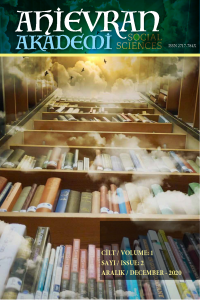The Representation of Cultures in English Language Textbooks: A Comparison of Three Textbooks Used in Turkey
Öz
Numerous studies have been conducted in the field of foreign or second language teaching related to the inclusion of cultural elements in foreign language textbooks. In this study, the reading passages from three different textbooks were examined in terms of four components of culture with the help of a checklist prepared by the researchers. One of the textbooks under examination is local, one is localized and one is global. In addition, the opinions of 14 English teachers were taken using two open-ended questions and a simple frequency analysis was carried out. The results indicated that Turkish EFL teachers believe the necessity of the inclusion of world cultures in ELT textbooks and most of them prefer using global ones. It was seen that local and localized textbooks do not possess the qualities which the names suggest. Finally, suggestions were made for textbook developers.
Anahtar Kelimeler
ELT textbook home culture international culture target culture
Kaynakça
- Ahmed, F., & Narcy-Combes, M. F. (2011). An Analysis of Textbooks from a Cultural Point of View. TESOL Journal, 5, 21-37.
- Alptekin, C. (2002). Towards Intercultural Communicative Competence in ELT. ELT Journal, 56(1), 57-64.
- Buttjes, D. (1991). Mediating languages and cultures: The social and intercultural dimension restored. In D. Buttjes & M. Byram (Eds.), Mediating languages and cultures: Towards an intercultural theory of foreign language education (pp. 3-16). Clevedon, England: Multilingual Matters.
- Byram, M. (1991). Teaching culture and language: Towards an integrated method. In D. Buttjes & M. Byram (Eds.), Mediating languages and cultures: Towards an intercultural theory of foreign language education (pp. 17-32). Clevedon, England: Multilingual Matters.
- Byram, M., & Feng, A. (2005). Teaching and researching intercultural competence. In E. Hinkel (Ed.), Handbook of research in second language teaching and learning (pp. 911-930). Mahwah, NJ: Lawrence Erlbaum Associates Publishers.
- Chen, M. (2011). Analysis of the Cultural Content in Senior High School English Textbooks in Taiwan. Unpublished Master's Thesis. National Taiwan Normal University.
- Cortazzi, M., & Jin, L. (1999). Materials and methods in the EFL classroom. in E. Hinkel, Culture in second language teaching (s. 196-219). Cambridge: Cambridge University Press.
- Çakır, İ. (2006). Developing Cultural Awareness in Foreign Language Teaching. Turkish Online Journal of Distance Education.
- Çakır, İ. (2010). The frequency of culture-specific elements in the ELT coursebooks at elementary schools in Turkey. Novitas-ROYAL, 4(2), 182-189.
- Çelik, S., & Erbay, Ş. (2013). Cultural Perspectives of Turkish ELT Coursebooks: Do Standardized Teaching Texts Incorporate Intercultural Features? Education and Science, 38(167), 336-351.
- Kachru, B. B. (1992). Teaching World Englishes. in B. B. Kachru, The Other Tongue: English Cross Cultures (s. 355-365). Urbana: University of Illionis Press.
- Kachru, B. B. (2005). Asian Englishes: Beyond the Canon. Hong Kong: Hong Kong University Press.
- Kılıçkaya, F. (2004). Authentic Materials and Cultural Content in EFL Classrooms. The Internet TESL Journal, 10(7).
- Kırkgöz, Y., & Ağçam, R. (2011). Exploring culture in locally published English textbooks for primary education in Turkey. CEPS Journal, 1(1), 153-167.
- Krippendorff, K. (2004). Content analysis: An introduction to its methodology. London: Sage Publications.
- Liu, K. (2016). Prioritizing Criteria for Evaluating Cultural Contents in EFL Textbooks through AHP. Journal of Language Teaching and Research, 7(5), 841-850.
- Lu, T. J. (2006). Hidden Curriculum in English Textbooks of Elementary School. Unpublished Master’s Thesis. National Chiayi University.
- McDonough, J. and C. Shaw. (1997). Materials and Methods in ELT. Blackwell.
- Mckay, S. (2000). Teaching English as an International Language: Implications for Cultural Materials in the Classroom. TESOL Journal, 9(4), 7-11.
- Neundorf, K. (2002). The content analysis guidebook. London: Sage Publications.
- Norrizan, R. (1993). Cultural Considerations in ESL Texts; A Sociolinguistic Approach at Facilitating ESL Learning in Towards More Effective Learning and Teaching of English. Proceedings Second International Conference. Malaysian English Language Teaching Association, (eds.) Hyacinth Gaudart & Maya Khemlani David. Selangor, Malaysia.
- Richards, J. (2002). The Role of Textbooks in a Language Program. Retrieved from: https://www.researchgate.net/publication/265455920_The_Role_of_Textbooks_in_a_Language_Program. 12.01.2019.
- Risager, K. (1998). Language Teaching and the Process of European Integration. Cambridge: Cambridge University Press.
- Tomlinson, B. (Ed.). (2008). English language learning materials: A critical review. New York, NY: Continuum International Publishing Group.
- Wu, J. (2010). A content analysis of the cultural content in the EFL textbooks. Canadian Social Science, 6(5), 137-144.
- Xiang, Y. C. (2007). A Cultural Content Evaluation on Senior High School English Textbooks. Unpublished Master’s Thesis. National Chengchi University.
- Yamanaka, N. (2006). An Evaluation of English Textbooks in Japan from the viewpoint of Nations in the Inner, Outer, and Expanding Circles. JALT Journal, 28, 57-76.
Ayrıntılar
| Birincil Dil | İngilizce |
|---|---|
| Bölüm | Araştırma Makaleleri |
| Yazarlar | |
| Yayımlanma Tarihi | 1 Aralık 2020 |
| Gönderilme Tarihi | 13 Temmuz 2020 |
| Kabul Tarihi | 28 Temmuz 2020 |
| Yayımlandığı Sayı | Yıl 2020 Cilt: 1 Sayı: 2 |

